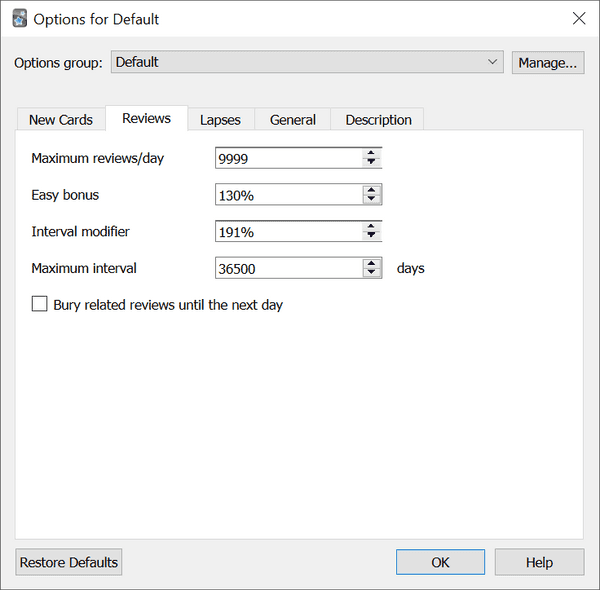

You can access your entire list of cards by going to the “Browse” section and selecting “Whole Collection” in the top left. In other words, it is a card in your list of cards to learn that you have never seen before. It means the number of new cards that you will see every day.Ī “new card” is in the learning phase. This one should hopefully be self-explanatory. The order tells Anki if you would prefer to see the cards in order added or randomly. Other Definitionsīelow are some of the more accessible settings to understand and so thought I would clump them all here. Therefore you would see that card again in 73 days. This means that the new interval of the 365-day interval card would be 365 * 0.2 (aka 20% of 365), which equals 73 days. In the example I have given, I have set the New Interval percentage to 20%. So starting them both again from scratch would be pointless. However, in reality, you probably know the card with the 365-day interval a lot better than the one with the 30-day interval. This means that whether the interval of the card was 365 days (meaning you haven’t seen the card in a year), or 30 days, you will start with a new interval of 1 day. This is what this option is for.īy default, this is set as 0%. Once you have relearnt it, the new interval of the card needs to be decided. forget a card), you start re-learning that card. The second thing you will find in the lapses tab is the New Interval. You don’t need to understand everything all at once. Go down to the section where I discuss the best Anki settings and just copy the numbers that I suggest. This is a bit complicated, so don’t worry too much about it if you are just starting with Anki. The whole point of this option is to tell Anki how well you want to relearn a card once you have forgotten it. It keeps decreasing until you reach 130% (where you multiply the intervals by 1.3). If it happens again, it will decrease another 20%. However, once you “lapse”, this decreases to 230%.

You see, while a card is in the learning phase, any time you press the “Again” button, the card goes back to the first number that you inputted in the steps option box (which was 60 minutes in the example given before).

This section is for when you forget your card after it has been graduated. This one is a bit easier to understand, so if you understood the “steps” section, you will get this in no time. If you are still confused then I suggest you check out this excellent video by Suppy M.D. The main difference between learning and graduated is that you can specifically say what the intervals are in the learning phase. Initially, you are in the learning phase, and the card is “graduated”. There are two phases that your card is in. If you want to see the card after one day, that is 1440 minutes. The reason that the numbers are weird is that you have to write it in minutes. If you press “again” at any point, you see the card again in 1 hour. Then the next time you press “good” you see it in 2 days. If you select “good” the first time you see a card, you will see it in 1 day. This means: 1 hour, 1 day, 2 days, 4 days Well, in this box you write down the intervals (represented as arrows on the image) that you want to see the card while in the learning phase (I will explain the learning phase below). So what does this have to do with the steps setting option? You can see that the interval between these reviews increases each time. For example, you might see a card on 1st Jan, then 3rd, 10th and 30th. You see the card at increasing intervals. It may seem a bit abstract but if you can understand this then you will be able to understand anything in this article.Įach circle represents when you review a card.


 0 kommentar(er)
0 kommentar(er)
